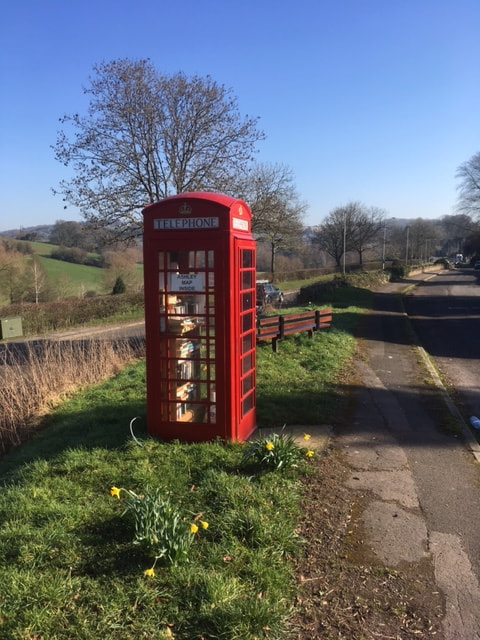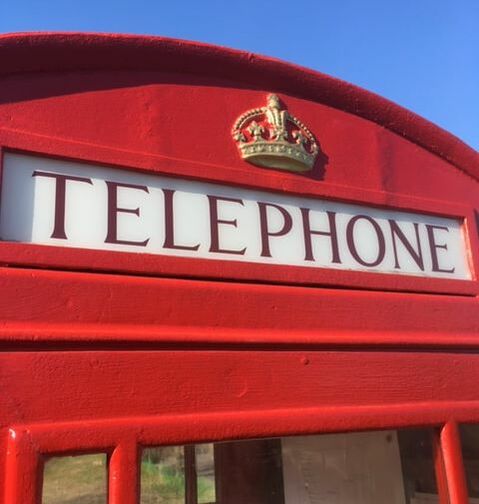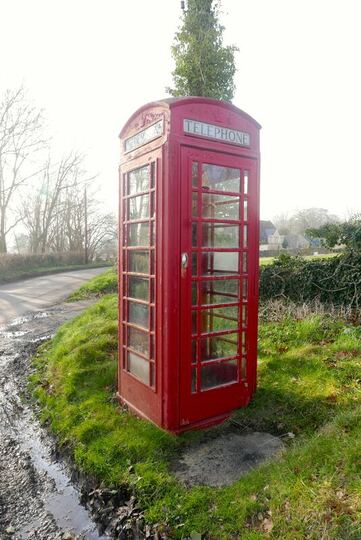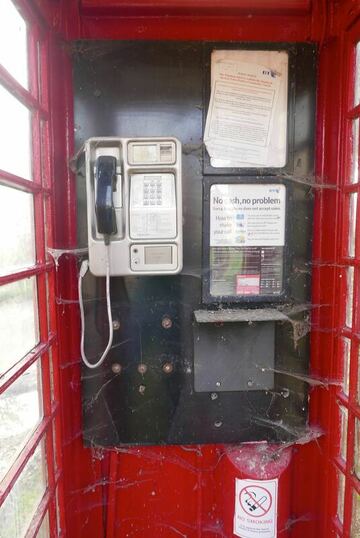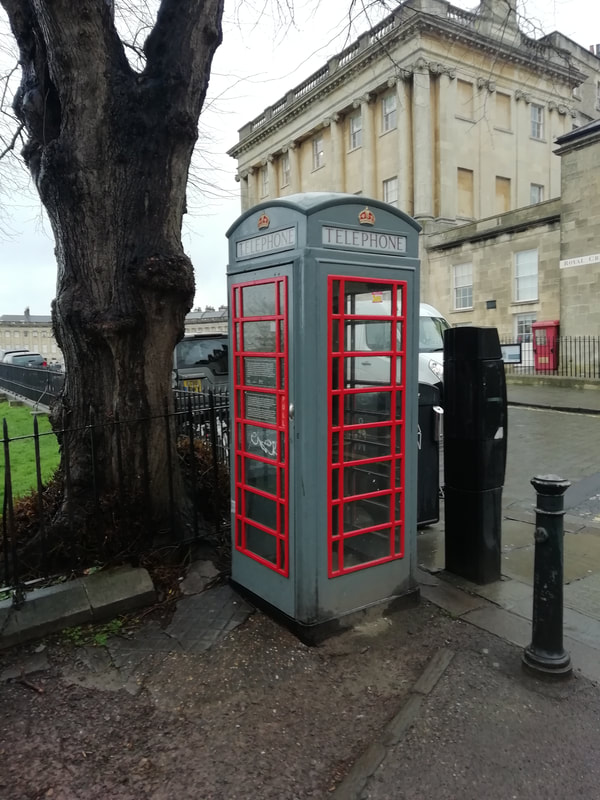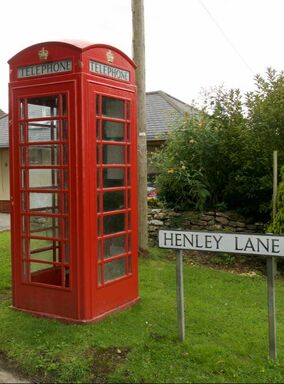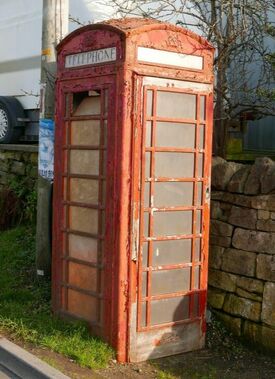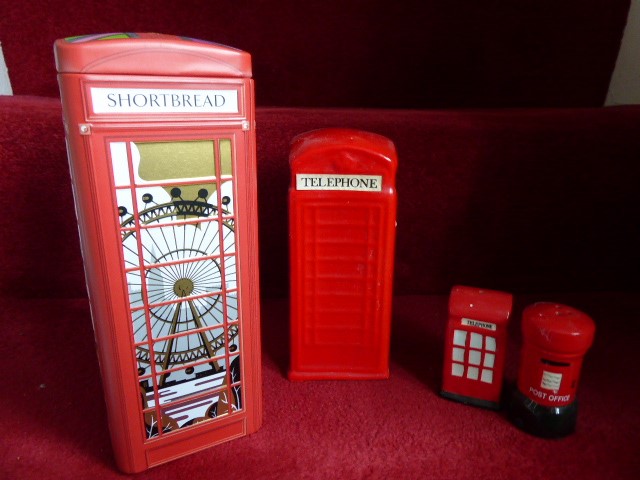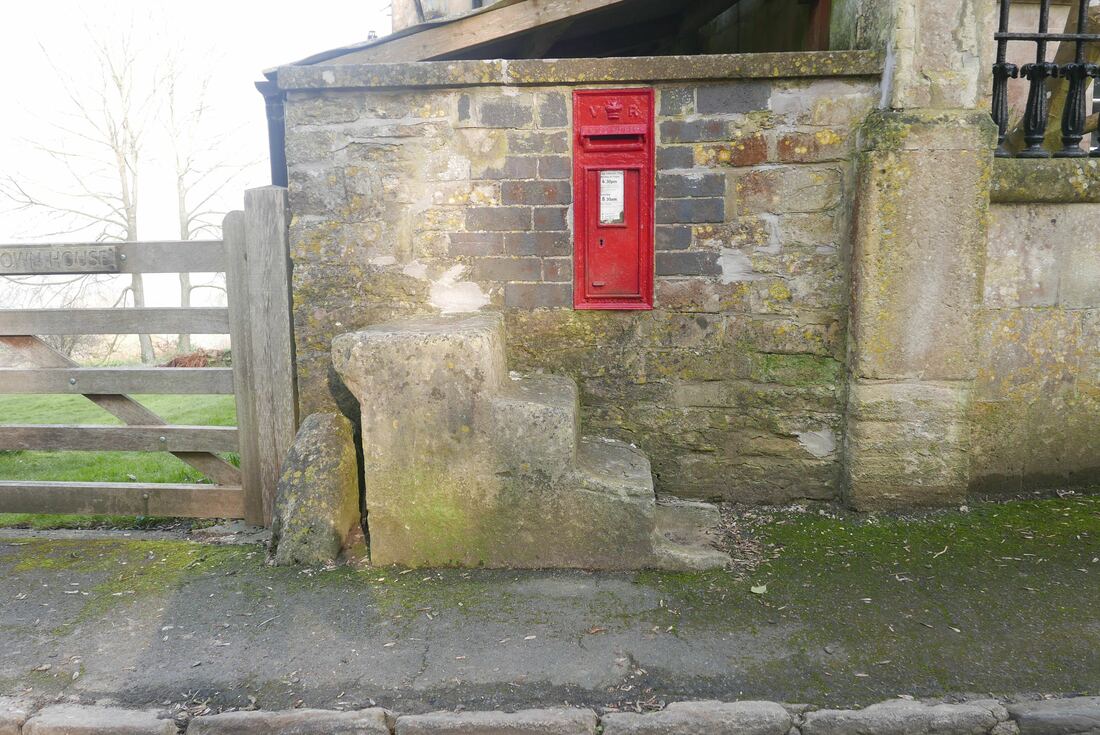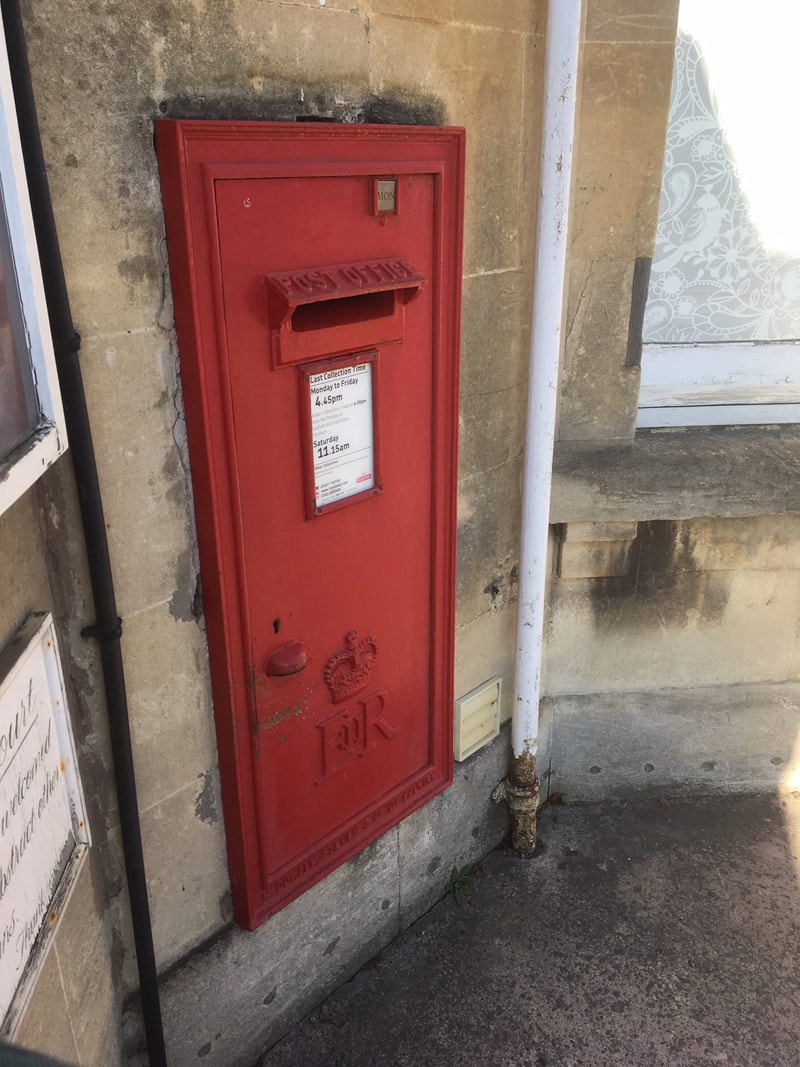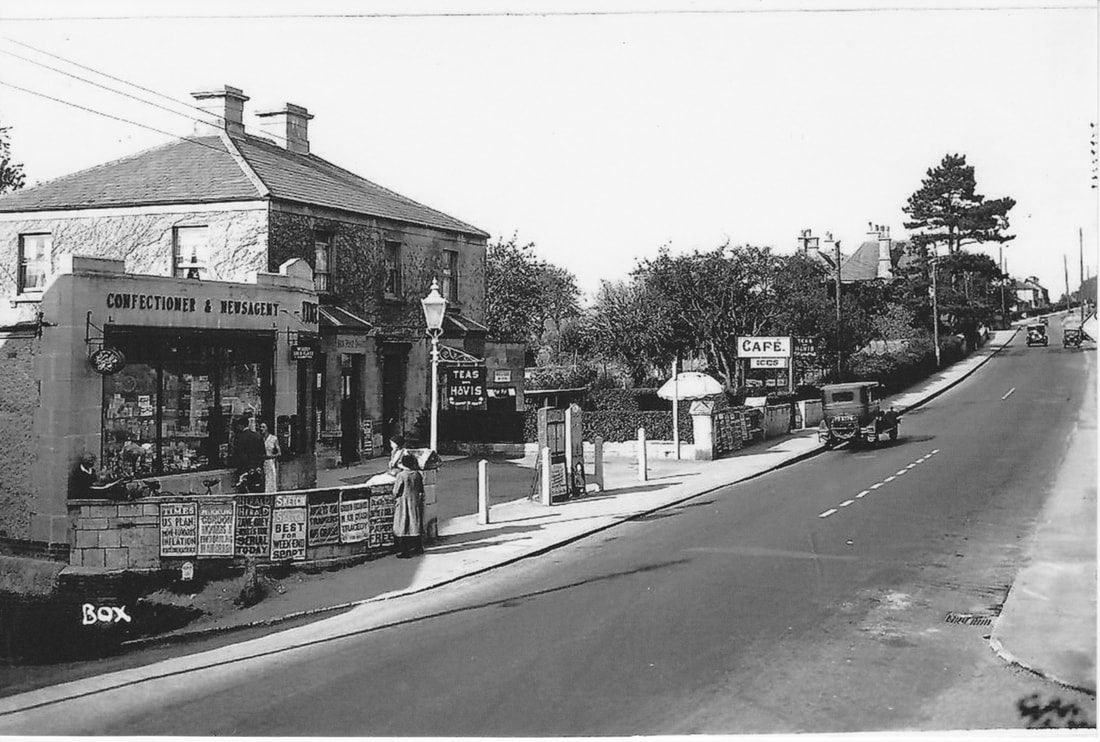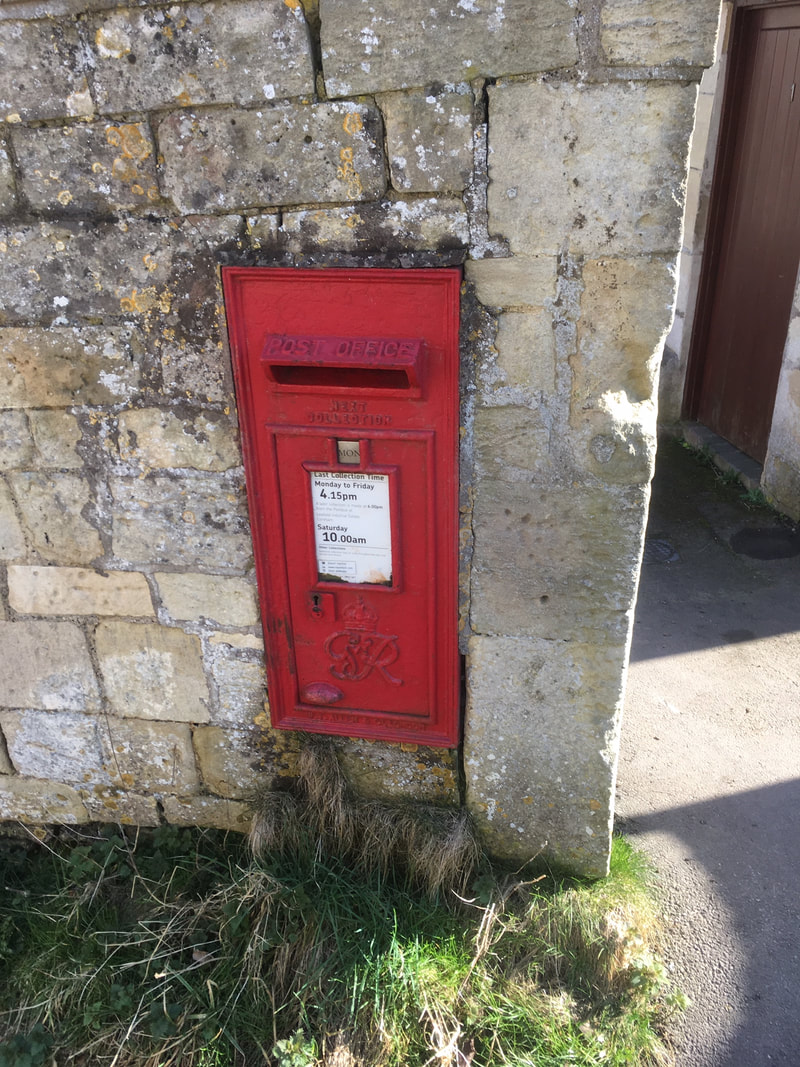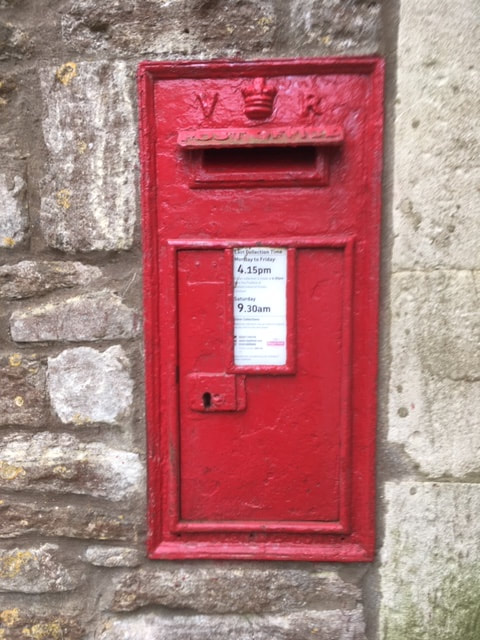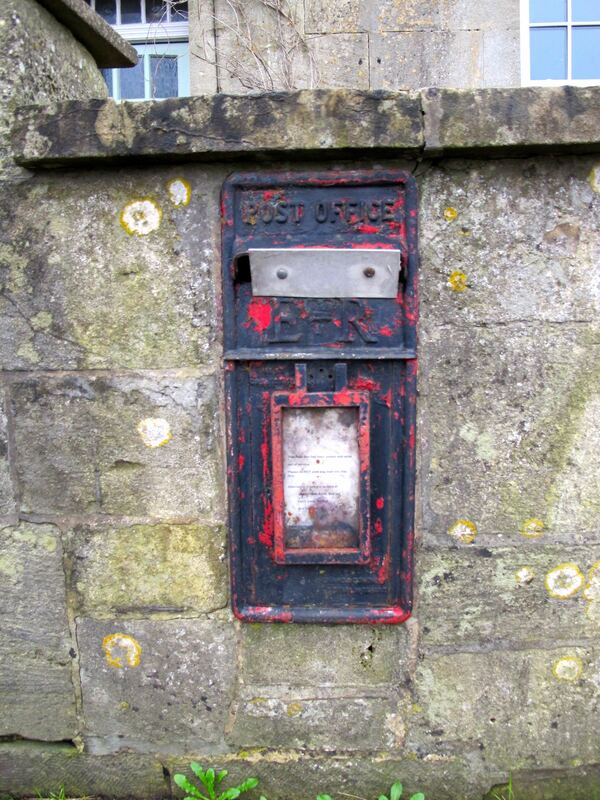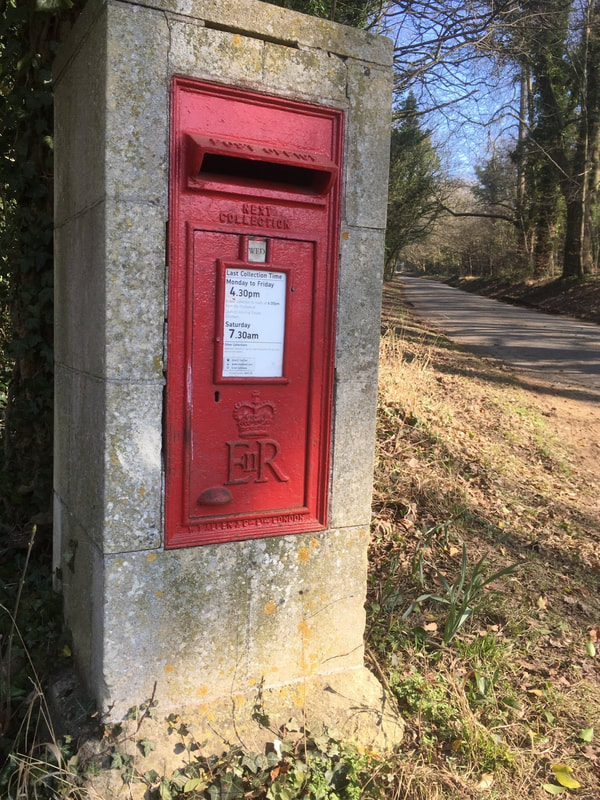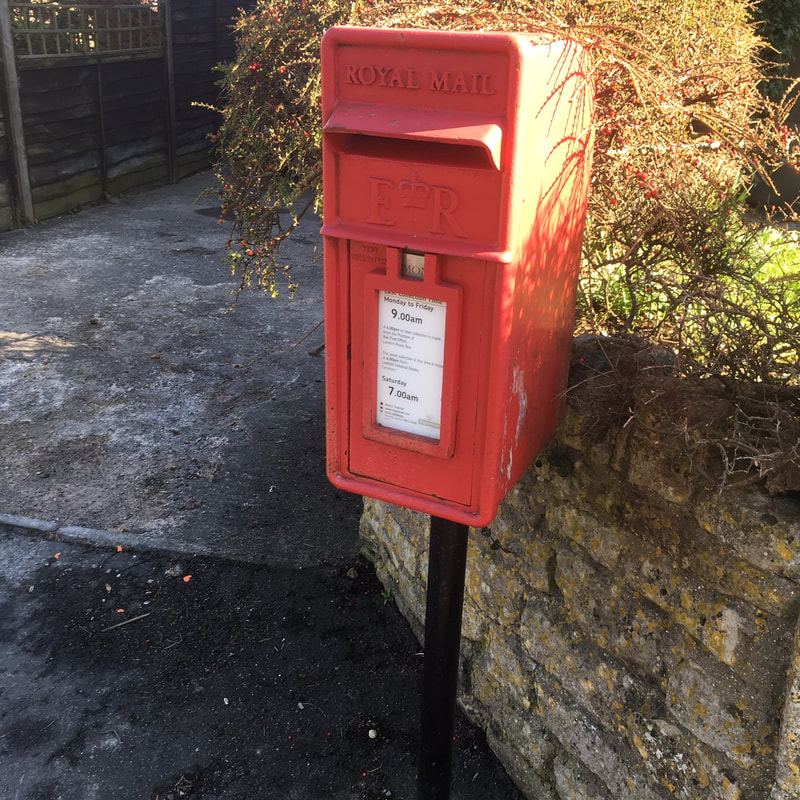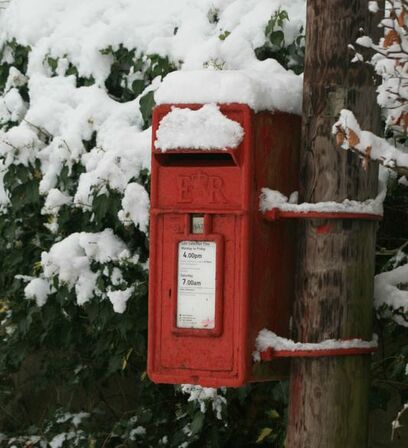|
Telephone Kiosks and Pillar Boxes in Box Varian Tye January 2019 Unless stated, photos Carol Payne When the K6 telephone box at Ashley was restored in June 2018, thirty residents turned up for an opening party.[1] Of course, it was a rather nostalgic event with modern cars moved out of sight and an old Morris Minor introduced as a reminder of the red box’s vintage. It was also an introduction into the future, the box converted into a local book library, an address map of houses in Ashley and a focal point for the people of the hamlet. No wonder then that there was a party atmosphere and a touch of British craziness. The underlying philosophy was to record and retain a part of the history of the village, in which telephone kiosks and letter boxes play a serious part. Right and Below: The Ashley Lane telephone box |
History of Phone Kiosk
The concept of a red telephone kiosk was introduced by Sir Giles Gilbert after the first boxes were mixed colours. Kiosk No 2 was first used in 1927 and restricted mainly to London and some large provincial towns. It established the popular image of what a phone box should look like. There were various models of different shapes and sizes in the 1920s until the design became standardised in 1935 with kiosk number 6 (the so-called K6 model based upon the same architects Kiosk No 2) introduced to commemorate the Silver Jubilee of King George V and is sometimes called the Jubilee Kiosk.
The concept of a red telephone kiosk was introduced by Sir Giles Gilbert after the first boxes were mixed colours. Kiosk No 2 was first used in 1927 and restricted mainly to London and some large provincial towns. It established the popular image of what a phone box should look like. There were various models of different shapes and sizes in the 1920s until the design became standardised in 1935 with kiosk number 6 (the so-called K6 model based upon the same architects Kiosk No 2) introduced to commemorate the Silver Jubilee of King George V and is sometimes called the Jubilee Kiosk.
|
The k6 kiosk could be erected in a single day and had a cast iron frame and teak door. It was illuminated by lighting controlled through an automatic timer switch.
In fact, the K6 was the first red telephone kiosk to be extensively used outside London. With a royal crown on the top of the box, they were a symbol of an innovative British government which controlled the world through the British Empire. Along with Big Ben, Tower Bridge and a police constable, the kiosks are still an instantly recognisable symbol of Britain. The K6 model was voted to be one of the top 10 designs along with the Mini car and the London Tube map. There were a few objections to the brilliant red that the post office decided should be a universal colour and, in some beauty spots, the boxes were painted battleship grey to reduce their visual impact. The K6 was responsible for a national catch phrase, Press Button B and try again later- the instructions for obtaining the return of money if the call was unanswered or otherwise unobtainable. |
After the K6 in the 1960s came modern replacements the K7 and K8. In 1985 British Telecom announced the death sentence on all existing kiosks to be replaced by an assortment of kiosks and booths based on American and Continental designs. According to some commentators at that time there were sixty thousand Scott kiosks still in use.
Campaigns were launched to save the old kiosks. As a result, some K6 kiosks were listed as buildings of special architectural or historic interest or purchased by local communities to conserve, others went to the scrap yard or found ignominious uses, such as converted to an internal shower room, greenhouse or K6 cocktail cabinet. Well done to those in the Parish of Box who answered the final emergency call from their K6 and conserved it as part of our local heritage.
Box’s Other Kiosks
The K6 kiosk at Ditteridge is a protected building as it was listed Grade II in 1991. It is situated in the Ditteridge Conservation Area at the side of the triangle of grass opposite The Bungalow. The listing reads: Designed 1935 by Sir Giles Gilbert Scott. Made by various contractors. Cast iron. Square kiosk with domed roof. Unperforated crowns to top panels and margin glazing to windows and doors. It is the only working kiosk in the area. (Photos of the Ditteridge kiosk below courtesy Varian Tye).
Campaigns were launched to save the old kiosks. As a result, some K6 kiosks were listed as buildings of special architectural or historic interest or purchased by local communities to conserve, others went to the scrap yard or found ignominious uses, such as converted to an internal shower room, greenhouse or K6 cocktail cabinet. Well done to those in the Parish of Box who answered the final emergency call from their K6 and conserved it as part of our local heritage.
Box’s Other Kiosks
The K6 kiosk at Ditteridge is a protected building as it was listed Grade II in 1991. It is situated in the Ditteridge Conservation Area at the side of the triangle of grass opposite The Bungalow. The listing reads: Designed 1935 by Sir Giles Gilbert Scott. Made by various contractors. Cast iron. Square kiosk with domed roof. Unperforated crowns to top panels and margin glazing to windows and doors. It is the only working kiosk in the area. (Photos of the Ditteridge kiosk below courtesy Varian Tye).
Inside the kiosk on the top right of the photo is a notice from BT dated 2009 saying the box is insufficiently used to be viable for telephone services. It can be bought by the parish or community council for the sum of £1 ensuring that the kiosk is retained in its current location. Any offers?
Attached is a photo of a listed Grade II K6 kiosk in Bath. The kiosk is not in Box and obviously isn’t red. A notice in the kiosk explains the controversy regarding the colour red chosen for the K6 when launched across the country. To mitigate outcry against the intrusive bright features, the General Post Office sanctioned muted colour schemes in areas of natural and architectural beauty. The Bath kiosk is a rare surviving example of a grey K6 kiosk.
Attached is a photo of a listed Grade II K6 kiosk in Bath. The kiosk is not in Box and obviously isn’t red. A notice in the kiosk explains the controversy regarding the colour red chosen for the K6 when launched across the country. To mitigate outcry against the intrusive bright features, the General Post Office sanctioned muted colour schemes in areas of natural and architectural beauty. The Bath kiosk is a rare surviving example of a grey K6 kiosk.
|
Now that most kiosks have been decommissioned for telephone use, some in the National Parks have been painted grey and some in Hull are cream (for the reason that an independent phone system operated there). In English rural locations red still seems to be the right colour to commemorate the phone kiosk’s antiquity in our mobile telephone age.
The telephone kiosk at Henley Lane (above centre) was lovingly restored recently, repainted and fitted out with books and local information for the hamlet. The historic K6 kiosk (right) at Box Hill was in poor condition and has been removed recently. Above and Right: K6 kiosks (courtesy Varian Tye) |
First Post Boxes
The first free-standing post box appeared in the England in the mid-1800s, sometimes coloured green, often square or hexagonal shape and they came into use partly at the suggestion of the author Anthony Trollope when he was working as a surveyor’s clerk for the Post Office in 1852. The traditional red colour, cylindrical shape, Royal Crown and the words Post Office all arrived in the 1880s. There are no free-standing pillar boxes that I am aware of in Box (can anyone correct me?).
A number of wall-mounted boxes exist in the village. These are the so-called Ludlow boxes, named after James Ludlow, the Birmingham manufacturer. The boxes were primarily for use in areas supervised by rural sub-post offices and they were the standard box for decades in the late 1800s and the first half of the 1900s. The oldest such post box I have found is the Victorian box at Kingsdown House (below), prominent above the horse-mounting block.
The first free-standing post box appeared in the England in the mid-1800s, sometimes coloured green, often square or hexagonal shape and they came into use partly at the suggestion of the author Anthony Trollope when he was working as a surveyor’s clerk for the Post Office in 1852. The traditional red colour, cylindrical shape, Royal Crown and the words Post Office all arrived in the 1880s. There are no free-standing pillar boxes that I am aware of in Box (can anyone correct me?).
A number of wall-mounted boxes exist in the village. These are the so-called Ludlow boxes, named after James Ludlow, the Birmingham manufacturer. The boxes were primarily for use in areas supervised by rural sub-post offices and they were the standard box for decades in the late 1800s and the first half of the 1900s. The oldest such post box I have found is the Victorian box at Kingsdown House (below), prominent above the horse-mounting block.
The letter box at the Post Office is modern and, as far as I can see, no early photograph shows a post box outside the building.
At Henley is a George V box, dating it before 1936 (below left). The oldest post box that I have found in Box is the Queen Victoria box at Ditteridge (below right), probably installed sometime after 1874 when the standardised red colour was introduced and before Victoria's death in 1901.
The post box at Highway on Box Hill (below left) has been painted over and looks old, but it has a Queen Elizabeth II insignia. It is an alternative version of the one at Middlehill (below right).
In later years, official letter boxes have been attached to posts, such as telegraph poles and free-standing posts. An example of this is below left at Chapel Lane and right at Box Hill. Obviously, the use of emails has seriously reduced the need for local boxes.
Epilogue to the Letter Box
In case you are thinking that modern technologies have caused the demise of our phone and letter systems, you would be wrong. In 1975 a poem was written to the Parish Magazine:[2]
In case you are thinking that modern technologies have caused the demise of our phone and letter systems, you would be wrong. In 1975 a poem was written to the Parish Magazine:[2]
|
RIP – the Demise of Hatt Letter Box
My dear, dear Hatt, receiver of my inmost thoughts, My heartfelt thanks, my oft excuse – The all-embracing love accept Of one who could not (always) trot to Box. Time was, I knew you not, and so Another post box took my mail – But where in this wide parish can I now find one so dear (so frail)? |
We worship progress – ha, the word
Denotes but large and larger things: The beastly truck did you knock out A pox on these engines without wings. And me? Your sorrowing friend remains. EMM |
We would love to hear from you about the post boxes or telephone kiosks in Box that we have missed or not recorded sufficiently.
References
[1] Parish Magazine, August 2018
[2] Parish Magazine, August 1975
[1] Parish Magazine, August 2018
[2] Parish Magazine, August 1975
